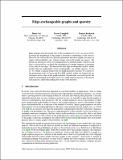Edge-exchangeable graphs and sparsity
Author(s)
Campbell, Trevor David; Broderick, Tamara A
DownloadPublished version (543.4Kb)
Publisher Policy
Publisher Policy
Article is made available in accordance with the publisher's policy and may be subject to US copyright law. Please refer to the publisher's site for terms of use.
Terms of use
Metadata
Show full item recordAbstract
Many popular network models rely on the assumption of (vertex) exchangeability, in which the distribution of the graph is invariant to relabelings of the vertices. However, the Aldous-Hoover theorem guarantees that these graphs are dense or empty with probability one, whereas many real-world graphs are sparse. We present an alternative notion of exchangeability for random graphs, which we call edge exchangeability, in which the distribution of a graph sequence is invariant to the order of the edges. We demonstrate that edge-exchangeable models, unlike models that are traditionally vertex exchangeable, can exhibit sparsity. To do so, we outline a general framework for graph generative models; by contrast to the pioneering work of Caron and Fox [12], models within our framework are stationary across steps of the graph sequence. In particular, our model grows the graph by instantiating more latent atoms of a single random measure as the dataset size increases, rather than adding new atoms to the measure.
Date issued
2017-02Department
Massachusetts Institute of Technology. Department of Electrical Engineering and Computer Science; Massachusetts Institute of Technology. Computer Science and Artificial Intelligence LaboratoryJournal
Advances in Neural Information Processing Systems
Publisher
Morgan Kaufmann Publishers
Citation
Cai, Diana, Trevor Campbell and Tamara Broderick. “Edge-exchangeable graphs and sparsity.” Advances in Neural Information Processing Systems, 29 (February 2017) © 2017 The Author(s)
Version: Final published version
ISSN
1049-5258